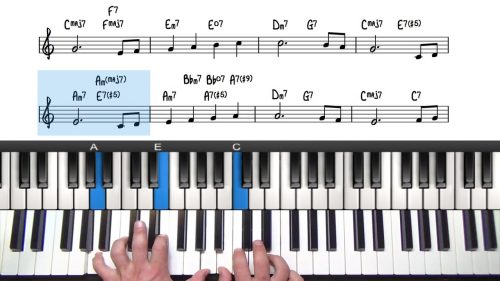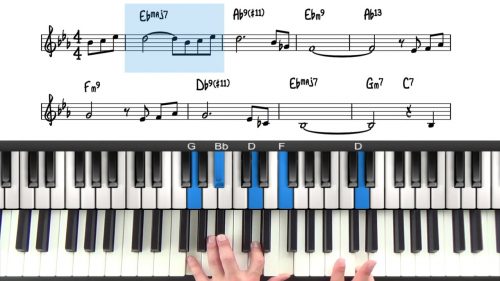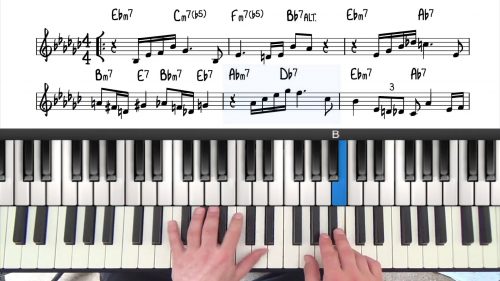2 Handed Minor 251 Tutorial
In this lesson we are going to look at some 2 handed minor 251 variations. In the previous lesson on the minor 251 progression, we covered the basic theory and learnt how to voice the chords in our left hand.
We know that in a minor 251 progression, the V7 chord is usually an altered dominant chord. Adding alterations is done by either raising or flattening the upper extensions of the chord. The upper extension are the tones 9, 11 and 13.
When we add alterations to the V7 chord it creates extra tension and dissonance and this strengthens the sense of resolution into the I chord.
In the introduction lesson on the minor 251, we explored the progression with left hand voicings. In this lesson we will spread the notes out over two hands to create bigger and fuller sounding voicings.
We start by exploring a new way that we can voice -7b5 chords. The voicing is constructed by playing the root and b5 in the left hand, and a major triad a whole step below the root in the right hand. This gives you the chord tones b7, 9, and 11 in the right hand so technically this is a -11b5 voicing.
We start off by constructing these voicings in a few different keys and then apply the progressions to 3 well-known jazz standards: Tenderly, Round Midnight and In a Sentimental Mood.
Lesson Downloads
-
2 Handed Minor 251 Supplement File Type: pdf
Practice Tips
-
As an exercise, take these voicings around al 12 keys.
-
3 keys were covered in the lesson which is 1/4 of the work done!
-
The key is to remember the formulas in terms of scale degrees - that is the blueprint to apply to any key.
-
Study the accompanying lesson for applying these voicings in context of jazz standards.
-
Always analyse the melody note over -7b5 chords, if the 11th is in the melody, then the -11b5 voicing will be an excellent choice.
- If the 11th is not in the melody, you can always tweak the melody, or reharmonise the chord changes.






Hi Hayden, is the download here more relating to the left hand minor voicings from the previous lesson? It doesn’t look like the voicings you demonstrate in the lesson here – unless I’m misreading! Thanks!
Hi James,
Yes you are correct – the download is from the left hand minor 251 lesson.
There is a handout for this lesson which I have just uploaded to the downloads section. It’s more of a transcription of the lesson with annotations. I also need to tidy it up as it was generated from a midi file. I’ll do that this evening and then add it to the “Downloads” section of this page.
The most important thing to remember with the -11b5 voicing is the following formula:
Left Hand: Root and b5 Right Hand: Major Triad built a whole step below the root (but an octave up)
Work through a few keys and try to find the voicing using the formula… you will find it difficult and that’s how it should feel, your brain should have to work hard to identify and visualise the notes…. you then know you are making progress because you are taking the time to work it out.
If I can be of further assistance just let me know 🙂
Cheers, Hayden
That’s great, thanks Hayden. Yes, definitely a brain workout. Possibly more so having recently just drilled in alternative voicings from elsewhere – but this voicing is really nice – I also like resolving to a bigger i – root and b7 in left, 2, b3 & 5 in the right – though this is largely habit! 🙂
Yes that’s also a nice place to resolve to. With anything I teach James, you should always experiment. If you like the sound of something then follow your ears and play it. That’s the beauty of this music.
I try to teach general concepts, or ideas for voicings and then it’s down to the student to take it in their own direction, add to it, change it, tweak it, and ultimately, make it your own 🙂
ps. I have updated the lesson download – the notation is now fully accurate and I’ve added improved annotations and guidance.
If I can be of further assistance let me know.
Cheers, Hayden
Brilliant, cheers Hayden 🙂
Hi Hayden. The -11b5 voicing is fantastic! I love voicings that are formulas beautiful, stick in your brain and then become easy to grab. I think they’ll work as a substitute for -7b5 too, right?
Hi Robert,
Good question!
Yes that is correct, this exact same voicing can function as 2 related dominant chords.
For example, D-11b5 is the following notes:
D = root, Ab = b5, C = b7, E = 9, G = 11
If we add a Bb as the root of the voicing, it becomes Bb13#11
If we add an E as the root of the voicing, it becomes E7#5#9
Also if we take this original voicing and move all of the notes up a minor 3rd, we have a rootless G7#5#9 or a rootless Db13#11.
Let me know if you have any further questions here.
Cheers! Hayden
Hi Hayden,
Can you include this voicing in the Chord Voicing Cheat Sheet. It would be good to have all the main voicings in on place (possibliy in one page?).
Thanks,
Alex
Hi Alex,
Yes you can find this -11b5 in the chord voicing cheat sheet:
https://www.pianogroove.com/wp-content/uploads/2017/12/Voicings-Cheat-Sheet-1.pdf
See the 4th voicing in the “Common Half Diminished Voicings”.
Is that the PDF you are referring to?
Cheers, Hayden
Yes, it is. Sorry, I didn’t recognize it there.
Regarding the V7 chord, there’s no rule for it as there is for the -11b5 chord?
Thanks,
Alex
HI Alex,
Yes that’s a good point, I can add another row to the PDF which shows the 2 altered V7 voicings which are #5#9, and #5b9.
Leave it with me and I will update the PDF file.
The ‘rule’ or ‘formula’ is that the left hand plays the shell of the V7 chord (root and 7) and the right hand plays 3-#5-#9 or 3-#5-b9.
I will add both to the chord voicings document.
Cheers! Hayden
Typo on this sheet?? Or did I miss something.
Hi John,
Thanks for letting me know about this and yes it is indeed a typo. I believe this PDF was created by a student using a MIDI program and I should have checked it more thoroughly before uploading it.
I will correct the typo and re-upload it.
Little typos can creep into the notation here and there and so if ever in doubt please follow the demonstrations in the video. My notation skills are clearly not as sharp as my arranging skills 😅.
Thanks again for letting me know and I will fix the error shortly.
Cheers, Hayden